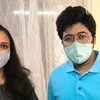From habit to impact: how creativity can transform lives and livelihoods
This compact book shares a range of tips and lessons to become a more creative person. Here’s a sample.
Foundations and examples of creativity in action are described in the new book, Creativity: The Key to a Remarkable Life, by Firdaus Kharas. Each of the 100 short chapters captures a message about creativity.

Firdaus Kharas is an author and practitioner of creativity and communications. His work includes use of animation in media for social change. The India-born author who studied at Cathedral School in Mumbai is now based in Ottawa, and is the founder of Chocolate Moose Media, a social enterprise. He has won the Peabody Award, and recognition for work in global development.
The 11 sections in the compact book span 130 pages and make for a pleasant read, though the reference section could have been more detailed. The book profiles the works of creators like Charles Schultz (Charlie Brown cartoonist), Gerrit Rietveld (Dutch designer), Gerald Genta (Swiss watch designer), and Ettore Sottsass (Italian architect).
Here are my takeaways from the book, summarised in the six clusters below. See also my reviews of the related titles How to Steal Fire, The Art of Noticing, Quirky, A Beautiful Constraint, How to get to Creative Ideas, The Creative Curve, and The Art of Creative Thinking.
The author also highlights the importance of creativity in the time of coronavirus. The pandemic has revealed the critical need for creativity to find responsive solutions, right from the home and hospital to business and government.
1. Foundations
"Creativity can change your life if you open your mind," Firdaus begins. Anyone can become a highly creative thinker if they use their imagination and embrace new ways of thinking. The book distills principles from 25 years of his experience in the field.
The author defines creativity as the “ability to think differently via a mental process of original thoughts that leads to the creation of new ideas.” Creativity applies to fields as diverse as maths, physics, photography, and art. From hard science to entertainment, creativity powers a range of human activities.
“Creativity is a mental balm for the soul,” he describes. Each person’s discovery, journey, experience, expression, and impact of creativity is unique. “Creativity is a transformational thought process,” Firdaus writes. It is about being open-minded, inclusive, and different.
“Creativity must have authenticity. You need a genuinely new idea,” he emphasises. However, this doesn’t have to be a single big ‘Aha’ or Eureka moment. It can be a series of iterative ideas and prototypes that examine multiple angles through a range of solutions.
There is also an element of risk-taking and dealing with unknown outcomes in creativity. “Failure is very much a part of the creative process,” Firdaus cautions. “New ideas involve some degree of risk because they haven’t been tried,” he adds.
Creative people have tenacity; they do not see failure as weakness. Instead, they accept failure as part of the journey, learn the lessons, and move on. At the same time, creators also need to know when they are hitting their heads against the wall, and look for other options.
2. Misconceptions
The author debunks a number of myths and misconceptions about creativity. Creativity is more about personality and mindset than intelligence. “Creativity does not require a high IQ or great knowledge,” Firdaus emphasises. Creativity is not about being perfect, but accepting some flaws.
Creativity is much more than a product, which is merely the outcome of a creative mindset and intangible qualities. Creativity precedes innovation, and companies that want to innovate must first focus on creativity.
Creativity involves imagination and intuition, and not just analysis or logic. It is not determined only by the activities of focus groups, or by asking customers what they want (‘faster horses’ rather than cars).
Brainstorming is not the starting point of creativity; it builds on individual creativity and evolves earlier ideas, and care should be taken to avoid groupthink. Unfortunately, many organisations have “severe or mild” dictators who kill creativity in others and are not open to suggestions.
3. Creative habits
The results of creativity are all around us, from products to services. “Widen your perception to see creativity everywhere you look,” Firdaus urges. Even the name of someone else’s pet has the owner’s creative process behind it. There is inspiration all around, you just have to look for it.
Surrounding yourself with creative and even unusual objects can help make you think more creatively as well. “Embrace wild ideas,” Firdaus writes; this can include writing down seemingly crazy ideas like wearing different socks, and even trying them out.
Boredom and daydreaming can actually open up unexpected connections, and can be channeled effectively into solutions. Letting the mind wander from present stimuli and foci can open up new possibilities, he suggests.
At the same time, creators need to have a sense of focus and change unwanted habits. Having a regular rhythm or routine for creative activities also helps.
Creativity exercises call for persistence. For example, Firdaus tests readers by asking them to come up with at least 50 different ways of lacing and tying shoelaces.
Another exercise is spending 10 minutes doing whatever you want with a piece of paper, string, and pencil – and recording and reflecting on the results. More such exercises would have been a welcome addition to the book.
Creativity involves following up ideation with actual “doing,” as seen in the works of Thomas Edison, the Wright brothers, and Tim Berners-Lee. Some discoveries may be accidental, such as X-rays and penicillin. Other involve making creative connections across different fields, such as observations from nature, eg., Swiss engineer George de Mestral’s invention of Velcro.
Creative people proactively go out and seek problems, even in the face of constraints or by stepping out of their comfort zones. “Creative thinkers are often attracted to the difficult or the complex,” he observes. Tackling health challenges like disease or human problems like assault are some examples.
Creativity can also arise from embracing seemingly impossible tasks and challenges, he adds, describing how he first took on the assignment for creating Al Jazeera TV shows on values for children. “With creativity, nothing is impossible,” Firdaus emphasises.
At the same time, creativity also involves accepting that some limits may exist. But these limits can be broadened and new frontiers can be explored. Not everyone can paint like Rembrandt, but Mark Rothko developed a style called ‘colour field painting’ based on rectangles.
Creativity is not about being able to see the future. It is about starting with today’s realities on the ground, building on earlier ideas, and pushing the frontier.
Creative thinkers need to have confidence in themselves and their ideas. They need to push back against other experts, which is often needed during ‘creativity by committee.’
“Creativity is brevity,” the author explains, stressing the need for effective communication to bring about customer behaviour change. Examples include taglines like ‘Don’t wait, vaccinate.’
Unfortunately, creators will need to confront a range of communication barriers to get their messages across to audiences. The author lists a number of such barriers, including culture, status, stereotypes, tradition, intolerance, and prejudice. Creativity helps in this communication as well, and not just in creating the offering.
4. Impacts
A creative mindset leads to lifelong learning, empowerment, and enrichment. Some creative impacts can last beyond one’s lifetime, as seen in the music of composers like Beethoven.
Creativity helps at the personal level by improving relationships, and at the professional level via competitive advantage. Harnessing creativity at the organisational level can also lead to corporate wealth generation, as shown by companies like Apple, Amazon, and Google.
“Creativity will make you realise that you can make a difference,” Firdaus enthuses. This can be at the level of an activity or a person’s life, or even for a whole community or the world.
He cites examples of creativity in health education campaigns about malaria, with the use of animated mosquitoes. For a media campaign about violence, Firdaus designed images with people having blue skin, so that it would not bring up existing biases about race. For HIV/AIDS campaigns, he depicted condoms through animations for better effect.
Creativity can help reduce stress and anxiety during tough and uncertain times, and find options that are elusive to others. Creative thinking can also help dissipate negativity. “Creativity can help you handle difficult people,” he advises.
“You will have more fun in life as a creative thinker,” Firdaus explains, referring to the role of humour in the creative process. Creativity can improve one’s curiosity, and helps ask multiple diverse questions.
For creative ideas to have social impact, they need to be human-centered. The audience should be the priority while designing useful products. Creativity in this context is not just about being different, but making sense.
5. Creativity: the COVID-19 impact
Citing industry sources, Firdaus explains that over the past three years, creativity has been consistently regarded as a highly-valued ‘soft skill’ - especially relevant now in the times of coronavirus.
“New processes had to be invented and new ways of thinking had to be found. Creativity became nothing less than a matter of survival,” he writes.
From policymakers to businesses, the demand for new and better solutions has arisen, including for other challenges like climate change and social justice. Some examples of such applied creativity would have been a welcome addition to the chapter.
6. Eight elements to implement creativity
The author describes eight elements to successfully implement creativity: enabling environment, a continuous focus on innovation, creative freedom, a culture of respect, multiple roles, supportive relationships, resources, and passion.
These are not always easy to implement. For example, Motorola pioneered mobile phones but could not position itself successfully in the smartphones segment. In many companies, new ideas are ridiculed and not given proper positive criticism.
Firdaus cites Singapore as an example of a country that has recently accepted the importance of creativity in the economy. It now has thriving tech and media sectors.
The road ahead
Some creative journeys can be a solitary pursuit, as seen in the work of cartoonists like Charles Schultz. “Don’t be afraid of a solitary journey into creativity,” Firdaus advises. At the same time, pairs or groups of collaborators can become creative when they have complementary strengths.
Challenges continue to arise in being able to place a specific measure or value on creativity, which can change through the ages. Almost no one bought Vincent Van Gogh’s paintings during his lifetime, the author observes.
The education system needs to improve in how it teaches creativity in schools. Unfortunately, children’s imagination diminishes as they grow older. “Rediscovering your creativity will be an awakening. Embracing creativity means you will change,” he suggests.
A life of creativity can give rise to a series of highs or peaks. It helps achieve personal and professional success while also giving back to society. The best use of creativity is to create a “remarkable life”.
“Creativity is the most important skill in a changing world,” he writes. Ultimately, human progress is driven by innovation. “The future of the planet depends on creativity,” Firdaus signs off.
Edited by Megha Reddy












